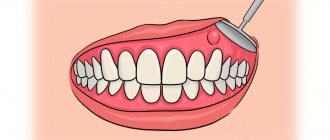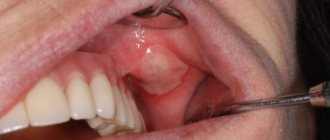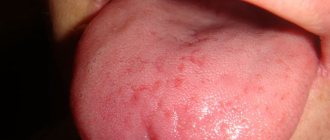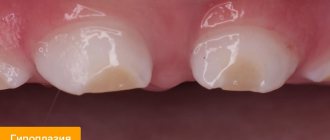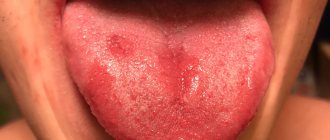What is a fistula
A fistula (gingival fistula) is a small seal on the gum. It is characterized by the presence of an open canal, as well as the constant discharge of pus. In many cases, the presence of such a fistula can be recognized visually when a tubercle appears on the child’s gum, the diameter of which usually does not exceed 2 cm. It has a reddish tint, gradually becomes inflamed, and a small funnel appears. As inflammation progresses, more signs of a problem appear.
It is important to pay attention to the fact that a child has such a pathology as early as possible. If this problem is not detected, the fistula can cause serious complications that will have a significant negative impact on the child’s health.
This phenomenon is especially dangerous for the reason that it often occurs in children when they do not yet know how to speak and cannot complain to their parents or describe the essence of the problem.
Next, we will talk about why a child has fistulas on the gums, what to do to prevent them and properly treat them.
How does a fistula form on the gum?
Below we will tell you exactly how fistulas form during periodontitis and periodontitis (and gradually move on to treatment methods), but you need to take into account that fistulas can form not only with these diseases. For example, if the fistulas are multiple, with copious purulent discharge, then cancer of the upper or lower jaw can also be suspected.
1) Formation of a fistula during periodontitis –
When a focus of purulent inflammation forms at the apex of the tooth root during periodontitis, the pus gradually formed in the focus of inflammation increases the pressure in it. Gradually, pus infiltrates the bone tissue around the tooth, and then, due to the high pressure at the site of inflammation and the heterogeneous structure of the bone tissue, the pus spreads into the bone in the direction of least resistance. Thus, a fistulous tract is formed in the bone tissue, through which pus penetrates under the periosteum of the jaw, forming an abscess there, which may look like a white lump on the gum (Fig. 5-6).
Further, the pus can break through the periosteum and mucous membrane of the gums, which will lead to the formation of a fistula. In this case, if the patient had an abscess on the gum in the form of a lump, then it sharply decreases in size, and in its place only a fistula opening remains. And in this case, patients usually complain that they have a pimple on the gum and a white spot on the gum, from which pus or cloudy liquid is released. When the purulent inflammation at the root apex temporarily weakens, the fistula can close, but if the tooth is not treated, it will certainly appear again.
Let us remind you once again that acute or chronic periodontitis itself can be a consequence of either untreated caries, or the development of caries under a filling or artificial crown, or a consequence of poorly treated root canals (if the root canals are not filled to the apex, if the root is perforated, etc. .), or be a consequence of physical trauma to the tooth. All these causative factors can lead to the appearance of a fistula on the gum.
2) Formation of a fistula during periodontitis –
In the presence of a form of gum inflammation called periodontitis, there is a gradual destruction of the attachment of the gums to the teeth + destruction of bone tissue, which leads to the formation of so-called periodontal pockets around the roots of the teeth (Fig. 7). They create good conditions for the proliferation of pathogenic bacteria and the formation of pus. If the pockets become deep enough, the drainage of pus along the surface of the tooth root may be impaired. In this case, a purulent periodontal abscess is first formed, in the projection of which a fistula on the gum can then form (Fig. 8).
Important: please note that if a fistula occurs on the gum, treatment can only be carried out by a dentist. And here we will immediately disappoint patients who expect to be cured without visiting a doctor, using antiseptic rinses or antibiotics at home. Such remedies can only allow you to temporarily suppress the inflammatory process, without permanently reducing the severity of the symptoms of inflammation (24stoma.ru). In this case, the fistula may close temporarily (until the next period of exacerbation of the inflammatory process).
Without professional treatment of the causative tooth, the fistula can indeed close on its own, but do not indulge yourself in the illusion that the problem will disappear. It’s just that the acute form of inflammation has temporarily turned into a chronic form with sluggish symptoms. For many patients, a fistula regularly forms in the same tooth over the years; pus constantly flows into the oral cavity, worsening overall health and giving the breath an unpleasant odor. Many patients ignore this, not considering it a problem, and often seek help from a dentist only when the tooth needs to be removed.
Causes of gum fistula in a child
In most cases, the occurrence of a fistula is provoked due to the fact that pathogenic microflora is created in the child’s oral cavity. The active development of pathogenic microorganisms leads to the fact that suppuration begins to gradually accumulate in the gingival tissues.
Dentists especially emphasize that fistula should not be perceived as an independent disease. Often this is just a symptom showing that there are serious problems with the child’s health, and an inflammatory process is developing in the body. And where there is inflammation, there are sources.
There are several reasons that can contribute to suppuration:
- Periodontitis. It often causes problems in young children when parents do not pay attention to caries of baby teeth. Often it is due to severe tooth decay that the inflammatory process begins. If baby teeth have already been replaced by molars, the source of inflammation will be located right next to the root. In this place suppuration begins to form. It gradually breaks through, and a fistula canal is formed with all the attendant dangers.
- Cyst. Often a fistula occurs at the site of a dental cyst. This is the name for a formation on a child’s gum, inside of which fluid begins to accumulate. Then everything happens according to the same mechanism as in the case of periodontitis. Once there is too much liquid, it begins to break out.
- Osteomyelitis. Another common source of inflammation. It concentrates in the gum area. If you do not start treatment on time, you may experience bone tissue decomposition. A focus of infection is created, the inflammatory process is constantly progressing. The appearance of a fistula is inevitable, because at some point there is too much pus and the tissues cannot hold it.
- Gum injury. The reasons may be different - too hard a toothbrush, improper oral hygiene, scratches, gum punctures when eating food. Such a small wound becomes a source of infection in the body.
Determining the causes of inflammation and suppuration becomes the main task of the dentist. It is important to understand what exactly caused the fistula. Our dentists use advanced diagnostic methods to identify the source of the problem as quickly as possible and eliminate it using one of the available methods.
Cause of primary fistula
Sinusitis is one of the causes of primary fistula. After removing a diseased tooth in the upper jaw, there is a risk of the formation of a fistula tract (ostium) between the maxillary sinus and the oral cavity through the tooth socket. Bacteria penetrate through it from the oral cavity, which provokes inflammation of the sinuses. Usually the hole lasts from 7 to 10 days, then it epithelializes and takes the form of a fistula tract. This is the so-called primary fistula. A secondary fistula forms after an unsuccessful operation.
Features of fistula of a milk tooth
Many parents wonder whether there is a risk of developing a fistula when the child’s baby teeth have not yet been replaced by molars. There is a common myth that in this case there will be no chance of suppuration.
But in practice, even with baby teeth, a fistula can develop. Its main source is caries. If you do not deal with timely treatment, caries can greatly destroy the tooth, a dangerous infection will be introduced into the gums, and the gradual development of suppuration will be stimulated.
The more damaged the tooth, the higher the risk. Therefore, our dentists recommend paying close attention to preventive examinations of baby teeth in children. It is necessary to visit the dentist's office regularly to prevent an increase in the risk of the disease.
Fistula between tooth and gum
A hole between a tooth and periodontal tissue indicates the development of cervical caries or the complications it caused. Cervical caries can be located between the teeth and not be visible to the naked eye. Due to its inaccessible location, such caries often turns into pulpitis.
Pulpitis is an inflammation of the blood vessels and nerve endings located in the pulp chamber of the tooth. The chronic stage of the pathology may be accompanied by the formation of a purulent focus in the soft tissues. If pulpitis progresses to the next stage of periodontitis, several fistulas may appear at once.
The main symptoms of gum fistula in children
It is very important to understand that a child is at risk of developing a fistula at a very early stage. But often parents in precisely this situation cannot find any signs of a problem. Inflammation can indeed form without serious external manifestations.
But as the disease progresses, the symptoms become more and more severe. First of all, a small swelling appears at the site of inflammation. Over time, it begins to become more and more pronounced, turns red, and the tissues can warm up from the inside.
Symptoms change with development. Among the important indications:
- It's a dull pain. Usually it turns out to be quite strong, the child begins to complain and be capricious. It may pass for a while and this will lull your vigilance. But there is a serious risk that the sensations will soon return and be even more noticeable.
- Swelling on the gum. It may look like a small abscess, similar to those that sometimes appear on human skin.
- Cone development. Usually it is quite large in size and has a whitish tint. In the inflamed area, the pain intensifies and other unpleasant sensations appear.
- Tooth mobility. It becomes more noticeable as the disease spreads. The tooth becomes very loose, and in the later stages it can even come out of the gums.
- Discharge from the inflamed area. When you press on the gum, it begins to ooze pus and blood.
Also, in the later stages of inflammation, a strong bad breath appears, and other unpleasant symptoms may develop.
It is often possible to find a fistula even on your own during an external examination. Moreover, without a properly selected treatment program, inflammation can spread deeper into the tissue and gradually worsen.
Symptoms accompanying the appearance of a fistula:
- pain, which, however, may not be present;
- mobility of the tooth next to which there is a hole;
- swelling and redness of the affected gum;
- purulent discharge from the hole.
It is difficult and excruciating for children to endure pain, so if these signs are detected, you should seek medical help immediately. Doctors at Family Dentistry know how to work with young patients, and many years of experience guarantee a correct and painless solution to the problem.
At the clinic, the doctor will first identify the cause of the disease. They may be:
- Insufficient oral care. The consequences are caries, and in the absence of proper treatment - pulpitis on one or more teeth. Later, the inflammation descends into the ligamentous tissue of the tooth, where a cavity with pus is formed;
- inflammation of the gums;
Diagnostic methods
Typically, parents or a dentist detect fistulas at a very early stage. They are localized on the outer or inner side of the gums and reveal themselves by noticeable swelling and the appearance of a whitish lump.
It is very important not to self-treat when a problem is discovered. If your baby has baby teeth, improper treatment can pose a risk to the formation of the dentition. When the teeth are molars, there will also be a lot of problems, and there is a risk of needing extraction.
At the dentist's appointment, the doctor will carefully examine the child and take an x-ray. The location of the inflammation, its nature, and estimated depth are taken into account. Already at the first visit, the doctor begins to develop treatment methods to try to solve the problem without surgical intervention.
Diagnostics
If a fistula is found in the child’s mouth, you should consult a doctor as soon as possible. Diagnosis involves taking a history and physical examination; in most cases, an x-ray is required to assess the condition of the teeth at the site of the lesion. If sinusitis or osteomyelitis is suspected, diagnostic measures are taken to identify these diseases.
Child at the dentist
The main risks of gum fistula and the risk of complications
Without proper timely treatment, fistulas often cause complications. They can affect not only the oral cavity, but also the internal organs of the baby.
There are several common risks:
- Severe intoxication of the body. Occurs because pus is constantly secreted from the wound. The pathogenic microflora that develops poses a great danger.
- Tooth loss. Sometimes it is necessary to remove only the one whose root has been affected. But cases with gradual spread of inflammation are also common, when several teeth need to be removed.
- Damage to the periosteum. It has far-reaching consequences associated with inflammation of tissues and bones, and the need for surgical intervention.
- Sinusitis. The infection quickly spreads to the human maxillary sinuses and begins to rapidly progress, covering ever larger areas.
Other dangerous potential complications include the need for perforation of the cheek, flux, removal of tonsils, and gastrointestinal disorders.
As with any other type of inflammation, the hours begin to count. Therefore, if a problem occurs, you need to seek dental help as quickly as possible.
Treatment
To effectively treat a fistula in a child, the cause of its occurrence must be eliminated. Fistulas that appear in places where baby teeth erupt usually do not require medical intervention, but it is still worth taking your child to the doctor. Perhaps the inflammation occurred due to the fact that the tooth cannot cut through the gum tissue and mucous membrane.
If the fistula occurs due to inflammation of the root of a baby tooth, it should be removed - the pathological process can spread to the permanent tooth germ underneath, which will lead not only to caries, but also to other complications. If the infection is extensive, it will be necessary to open and clean the canals, as well as scrape out the affected gum tissue. After opening the fistula, the wound is not sutured so that the pus can come out freely, and patients are prescribed disinfecting and physiotherapeutic procedures.
Treatment of an abscess on the gum
Treatment of permanent teeth depends on the extent of their damage - if the lesion is small, the tooth can be saved. Usually, in order to get rid of a fistula, several visits to the dentist are necessary. The doctor will open the canals of the tooth, remove the old filling if necessary, and clean the cavity of infected tissue and pus. After this, a course of antimicrobial drugs and antibiotics is usually prescribed to eliminate the infection. If no new foci of inflammation appear in the affected area, the dentist will fill the tooth. In cases where the causes of the fistula are sinusitis or osteomyelitis, comprehensive diagnosis and treatment of these diseases is necessary.
After surgery, a course of antimicrobial drugs and antibiotics may be prescribed
Main treatment methods
The answer to the question of how to treat a fistula on the gum in a child is given by the dentist after a careful examination of the patient and collection of anamnesis. It is important that the doctor considers the process comprehensively, using not only medication, but also therapeutic methods. Sometimes proper local surgical intervention is also necessary. Let's talk about each of the listed measures in more detail.
First aid methods
When parents and a child visit the dentist, they need to answer questions about how long ago the first symptoms appeared and whether the child has other concomitant diseases. At the first stage, the symptoms of the disease are relieved, and then a deeper plan is drawn up to eliminate the root cause of poor health.
There are several basic first aid methods:
- Relieving pain syndrome. If the baby has a high fever and all signs of inflammation, you can give him antihistamines - Nurofen, Cifecon, paracetamol.
- Reducing swelling. It is best to use safe gels, such as Kalgel.
- Removal of pathogenic bacteria. Most often, this reduces inflammation. It is recommended to rinse or carefully treat the affected area with Miramistin or Chlorhexidine.
First aid helps to slow down the spread of the inflammatory process and reduce it. But you should take medications only with a clear understanding that the baby is not intolerant to them. It is best to consult a doctor.
Subsequent drug treatment will be based on taking properly selected antimicrobial drugs, antiseptics, anti-inflammatory and antihistamines.
Surgical intervention
Surgery is usually the last option to correct the situation. Doctors resort to it when other means are completely ineffective.
The main reason for prescribing such treatment is the widespread spread of soft tissue inflammation. The area becomes more and more extensive, and pus is actively flowing from the fistula.
In this case, the doctor removes the fistula and scrapes out the affected tissue. Today, laser processing is used for this purpose, which automatically seals small vessels. The likelihood of infection is minimal and the procedure itself is much faster and painless than using traditional surgical instruments.
Next, depending on the situation, the question of the need to remove the tooth is considered. Often it can be preserved and done with simple filling of the canals. A more detailed answer to the question about treatment methods can only be given after a careful examination of the patient.
Features of treatment of fistula with concomitant diseases
Are there any particularities in the treatment of fistula if the process is accompanied by other diseases in the oral cavity, such as periodontitis? No, in fact there is no particular connection. Periodontitis is an inflammation of the periodontium of a tooth, while periodontitis is an inflammation of the apical tissues surrounding the tooth. Of course, in some very severe forms, periodontitis can lead to the formation of fistulas, but often these are all unrelated, and one should be treated separately. First, cure periodontitis, if the tooth is healthy, if it does not wobble and can be preserved, and then treat periodontitis.
How long does it take for a patient to recover after fistula treatment?
The treatment of chronic periodontitis itself is not quick, since the patient must first open the tooth canal, clean it, disinfect it with special antimicrobial drugs, and only after that the tooth canal is sealed. If we talk about rehabilitation, when the results are visible, the fistula “goes away” almost immediately, and the bone takes a long time to recover.
If we talk about the surgical method
treatment of periodontitis, when the apical part of the tooth is opened according to the type of resection, but the apical part of the root is polished, the mucous membrane is restored quite quickly - this is
3-5 days
.
How to treat a fistula at home
We emphasize that home treatment is only one of the auxiliary methods prescribed by a doctor.
At home, you will need to treat the oral cavity using special decoctions with a pronounced calming and antiseptic effect. You can use decoctions of calendula and chamomile, solutions of salt and soda.
Also allowed are lotions made from aloe and Kalanchoe, and the application of special ointments prepared at home. They are made using crushed chamomile herbs mixed with sea buckthorn oil.
This home treatment can significantly speed up the recovery period and reduce your child’s discomfort.
Prevention for baby's primary and molar teeth
One of the main aspects of treatment for a fistula in the gum area is compliance with the prevention requirement:
- Proper oral hygiene is the basis of prevention.
Keep your mouth clean by carefully performing hygiene procedures.
- Brush your teeth from early childhood, choosing the right toothpastes and special brushes.
- Carry out the procedure of rinsing your mouth after every meal.
- Treat dental ailments in a timely manner.
- Be sure to visit the dentist twice a year for timely detection and treatment of caries. Often, caries is the source of the development of fistula.
- Immediately show your child to a specialist if a purulent lump appears on the gum.
- Maintain food intake
- The diet should be balanced, rich in vitamins and calcium.
- Eat plenty of vegetables, fruits and solid foods.
By taking all precautions, the formation of a fistula and other dental pathologies can be avoided.
Prevention methods
Fistula can appear in any child, so it is very important to correctly approach the methods of its prevention. Among them are:
- Strict adherence to oral hygiene practices.
- Moderate consumption of sweets, avoidance of candies and anything that can hurt your gums.
- Regularly inspect your gums for damage.
- Treatment of infectious and inflammatory diseases.
- Periodic examinations at the dentist.
The sooner the problem is identified, the easier it will be to get rid of it and the less harm it will cause to the baby’s body.
Parotid fistula: what is the danger of an additional canal in the ear
Parotid fistula is a rather unpredictable disease. In some cases, the anomaly may not bother a person throughout his life, but sometimes it makes itself felt immediately after birth and threatens with serious complications. When surgical treatment is necessary, and when surgery can be avoided, said otorhinolaryngologist at the Morozov Children’s Hospital with 25 years of experience in treating the disease, candidate of medical sciences, holder of the “Moscow Doctor” status, Alexander Mikhailovich Ivanenko.
How does the anomaly manifest itself?
Externally, a parotid fistula looks like a barely noticeable point at the helix of the auricle. With an atypical location, the mouth can be located anywhere in the auricle, including the lobe. But this is very rare. The fistula itself is an additional passage covered with skin measuring 1.5 - 2 cm in length, which has a tortuous structure. Sometimes the fistula bifurcates or ends in a thick cyst-like extension. It can form in one ear or in two at the same time.
What are the causes of the disease?
Congenital parotid fistulas are the most common developmental anomaly of the external ear. Occurs in 15 - 43 children per 100,000, depending on the region. In 30% the disease is hereditary, in 70% it is sporadic, that is, it occurs from time to time. The appearance of a fistula is associated with abnormalities in fetal development. The defect forms at 9-11 weeks of intrauterine development. At this time, six ear tubercles are formed from the I and II gill arches, from which the structures of the auricle subsequently develop. Pathological processes during pregnancy (stress, respiratory diseases) lead to the occurrence of a defect.
Why is parotid fistula dangerous?
The fistula canal is lined with skin containing sweat and sebaceous glands, so contents of a yellow-curdled consistency accumulate and are periodically released. When a bacterial infection occurs, an inflammatory process develops that spreads to soft tissues. Huge pyogenic ulcers form on the skin, reaching 5 cm in diameter. A cosmetic defect significantly reduces the child’s quality of life. If the inflammatory process involves the cartilage of the auricle, perichondritis occurs, which leads to deformation of the auricles.
It happens that a congenital anomaly is misdiagnosed, mistaking it for other diseases: atopic dermatitis, eczema, osteomyelitis, skin tuberculosis and even systemic lupus erythematosus. Often children come to us after long but ineffective treatment.
Can parents independently detect a parotid fistula in a child?
In most cases this is possible. It is necessary to carefully examine the child and understand whether he has a small hole at the base of the ear curl or not. If there is a hole, but it looks like a small needle puncture and does not bother the child, there is no need to worry. The fistula is not dangerous and does not need to be removed. If the mouth is red, secretions are released from the hole, discomfort or pain appears - it is necessary to treat the mouth with a chlorhexidine solution and consult an otolaryngologist.
How is a congenital anomaly treated?
As a rule, patients come to us for the first time with an exacerbation of the disease. We treat the abscess and schedule a planned operation to remove the fistula. Surgical removal is performed only in the cold period, that is, not in the active phase of inflammation. Otherwise complications may arise. It takes about one and a half months to restore the skin after the inflammatory process is removed.
There are no age restrictions for the intervention. Our youngest patient was only three months old. Since birth, his fistula has become inflamed twice.
How is the operation performed?
The point of surgical treatment is to completely remove the entire fistulous tract. At the same time, the surrounding tissues cannot be damaged. A method based on the property of diaphanoscopy helps to recognize and highlight the pathological zone. My colleagues and I developed and patented the method several years ago, and we successfully apply it in practice.
During the operation, a sterile light guide catheter with a diameter of 0.75 mm is inserted through the mouth into the fistula canal. The catheter lights up and we accurately assess the length, shape and direction of the fistula, and the presence of possible branches. Then we gradually isolate the fistula from the surrounding tissues. The operation lasts from 40 minutes to an hour. This is a low-impact intervention. Previously, children spent 7-10 days in the hospital after surgery, but now they are discharged after 3-4 days. There is no need to remove sutures - we use absorbable suture material. If a child has a bilateral fistula, we remove the pathology from both sides at the same time.
We perform 20 to 30 such operations annually. Over the past years, vast experience has been accumulated in effective surgical treatment of congenital anomalies.
Popular questions
- Why did a child develop a fistula between his teeth?
Mainly, the formation of a fistula on the gum of a baby tooth develops against the background of long-term caries.
Usually, the initial stages of the disease are asymptomatic and often parents do not notice these symptoms. The only sign is the presence of white bumps formed between the teeth. Against the background of a violation of the integrity of the enamel and an unbalanced diet, caries quickly develops on the child’s healthy teeth.
- How to provide first aid?
Self-medication of a fistula in a child is unacceptable. Providing first aid consists of relieving the characteristic symptoms and making the child feel better. For these purposes, the oral cavity should be rinsed with an antiseptic, and the fistula should be treated with dental gel, which is used for teething. If necessary, give the child an antipyretic and antihistamine. Then he will immediately go to the dental clinic.
- There is something sharp on the child’s gum – what is it?
Inflammation of the gums involves thickening and swelling.
In such areas, the boundaries of purulent neoplasms are more clearly visible. On palpation, you can feel a hard lump with a sharp tip. What could it be? First of all, when a fistula is formed, a rod is formed. As the inflammatory process progresses in the soft tissues, the purulent secretion puts additional pressure on the rod.
As a result, it can push itself to the surface of the gum on its own. The rod does not always have sufficient density to disrupt the integrity of the thin periodontal film. Therefore, resting against the gum, it takes on a sharp shape.

